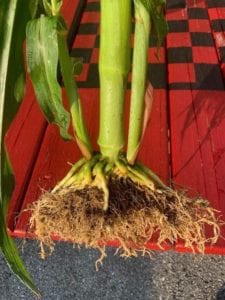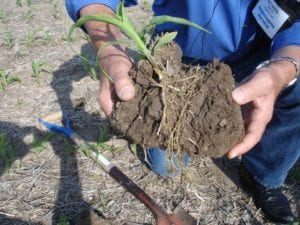By Louis Sutton
Regional Product Manager – Agronomy Lead
Whether you call it Floppy corn, Lazy Corn, or Rootless Corn, it has the same effect on your yields and the growth and development of your corn crop. It has a huge impact on your yields, ranging from 20-to-40 percent yield loss, and can happen in any soil type and with any planter. Ok after the last sentence you can tell this happens from the planter.
So, what is Floppy Corn and how can it be controlled? Floppy Corn, as I call it, is when the corn lays over or gets floppy at about V6 to V8 corn plant development. This can be confused with herbicide damage or shallow planted corn, which is called the same thing, so it needs to be looked at to find what is really causing the corn to lay over. Poor root development, not the hybrid’s genetics, is the cause.
I’m going to look at one of the most common types that I get called to see most often. When planting, the opening discs slide in the soil rather than turning as they should it; this causes an issue. This is caused by reduced friction between the soil and the discs. Moisture causes reduced friction and acts as a lubricant. This causes the soil to smear, pushes the air out of the soil, seals the soil off, and creates sidewall compaction. Without air, the roots will not penetrate the soil and instead grow along the seed farrow, forming a V of roots, with some growing out from the bottom of the seed furrow. This lack of good root development makes the corn fall over, or flop around, and reduces yields.
Controlling floppy corn is harder than some may think. It’s easy to say, “Wait until the soil is dry to plant.” Everyone knows this. But this is also a hidden yield robber. As you have walked fields, you have seen good ears, then a few steps later, you see about 10-to-20 ears that are smaller and less developed. You may not think much about this, but that can be a lot of yield lost that could have been prevented. The planter was working as it should when planting started, but then it began sliding and creating sidewall compaction before it started turning again. The main causes of this are wetter soils, too much down pressure, and not planting deep enough. So as the plants grow, it becomes difficult to see these smaller areas are flopping unlike if it was an entire field or larger area. By delaying planting just one day, this could have been avoided. I get called to fields every year to address areas like these producing smaller ears. Normally, the call happens when it’s two or more acres, but twenty feet also hurts the yields as they are spread all over the field and add up to a lot of acres never seen. We dig up the roots of good corn and poor corn ears and that’s where we find the V of roots that reduced yields. We have a lot of monitors on the planters now, but there’s not a monitor to let you know if the discs are turning as they should; this monitor would be worth its weight in gold.
As for now, we are the only monitors to address this issue. We check the field and then start planting, but we need to stop and check the soil conditions as we plant. Stop and make a ball of soil; if moisture and soil cling to your hand, it is too wet. If you see soil sticking to the closing wheels, it is too wet. Yes, this will slow down planting, but in the long run, it will pay you back. If you’re not sure, call your AgVenture Yield Specialist (AYS) and they will be happy to help you. We always want to rush planting and worry about the dates on the calendar, but we really need to look at the conditions we are planting into and not some date on a piece of paper. We make money at planting time and harvest; this is where we need to take our time and do it right. More yield is lost by poor planting than any other activity, in my opinion.


